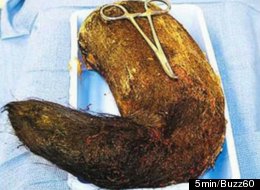Kids, don't chew your hair.
A 19-year-old-girl in Indore, India went to the hospital last month complaining that she "hadn't been able to eat or drink for a few days." Doctors performed an examination and discovered a massive blockage filling her stomach and small intestine.
The girl was rushed into surgery, and doctors removed a four pound hairball from her GI tract. The girl reportedly "had a bad habit of eating her hair and chalk while in class," and the resulting impaction created a truly stunning mass.
Formally known as a "bezoar," these impacted masses have been removed from people and animals for centuries. Bezoars can be formed from either organic or inorganic materials. In people they are often caused by pica (a psychological or medical condition which compels the sufferer to eat non-food items, such as hair or chalk). A bezoar composed mainly of hair is called a Trichobezoar. Premature babies fed formula will often form bezoars made from dried up lumps of formula powder, called a Lactobezoar.
Bezoars can also result from impacted masses of seeds, pits, or unripe pomegranates. In fact, the problem with unripe pomegranates causing a bezoar is so common that it has its own scientific name (Diospyrobezoar) and folk remedy (Coca-Cola).
Other animals form bezoars based on their specific biology. In some cases they are lumps of things the animal has eaten (the hairball of the house cat is a prime example of this). In other cases they may precipitate out as a chemical process.
In many cultures and eras, bezoars have been thought to possess magical and/or medical properties. In fact, the name itself comes from the ancient Persian word for "antidote," due to the belief that a bezoar served as a universal antidote against all poisons.
In Europe, the belief in the power of the bezoar was so strong that it wasn't until the mid 1500s that the belief was effectively debunked. Surgeon Ambroise Pare (widely considered "one of the fathers of surgery and modern forensic pathology") took a man who was sentenced to death by hanging, and gave him the option to risk "poison with a bezoar chaser" instead. The man chose poison, and died horribly, even with the application of a bezoar.
In Chinese herbal medicine, bezoars from an ox are still considered to have the ability to remove toxins from the body. Called calculus bovi, these bezoars are harvested from the gall bladder of cattle after slaughter. These small gall stones are somewhat rare, and are thus quite valuable. This has also given rise to a brisk trade in artificial calculus bovi which are made from cholic acid.
